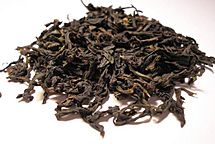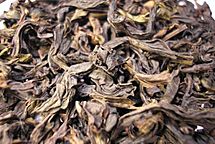Da Hong Pao facts for kids
  |
|
| Type: | Oolong |
|
|
|
| Other names: | {{{Tea_names}}} |
| Origin: | Wuyi Mountains, Fujian Province, China |
|
|
|
| Quick description: | |
|
|
|
Quick facts for kids Da Hong Pao |
|||||||||||
|---|---|---|---|---|---|---|---|---|---|---|---|
| Traditional Chinese | 大紅袍 | ||||||||||
| Simplified Chinese | 大红袍 | ||||||||||
| Literal meaning | Big Red Robe | ||||||||||
|
|||||||||||
Da Hong Pao (which means Big Red Robe) is a special kind of rock tea from the Wuyi Mountains in Fujian Province, China. This tea is famous for its unique orchid smell and a sweet taste that lasts a long time.
When the tea leaves are dry, they look like tightly twisted ropes. They are green and brown. After you brew them, the tea turns a bright, clear orange-yellow color. Da Hong Pao is so special that you can brew it up to nine times and it will still taste great! It is also known for being very expensive.
Contents
How to Brew Da Hong Pao Tea
To make Da Hong Pao tea, people often use a special Purple Clay Teapot. You should use very hot water, about 100 °C (212 °F). Many tea lovers think purified water is the best choice.
It's important to use the water right after it boils. If the water boils for too long, or if you let it sit for a long time after boiling, it can change the tea's taste. Many people say the third and fourth cups brewed from the same leaves taste the best.
How Da Hong Pao Tea is Made
Making Da Hong Pao tea involves seven important steps. These steps help create its special flavor.
Picking the Tea Leaves
Da Hong Pao tea leaves are picked only once a year, usually in May or June. Workers carefully choose one bud and two or three young leaves from each plant.
Withering the Leaves
After picking, the tea leaves are spread out in the sun. A gentle breeze helps to dry them out. This step is called withering.
Cooling the Leaves
Once the leaves have withered, they are brought inside. They are then allowed to cool down.
Shaping the Tea
This is a very important step. The tea leaves are shaken and rolled in a large bamboo sieve. This helps the tea leaves change and develop their special smell, taste, and unique feel. It is the most complex and time-consuming part of making the tea.
Stir-Frying the Leaves
Next, the leaves are stir-fried. This can be done by hand or with machines. For hand stir-frying, the pot is about 140–160 °C (284–320 °F). Workers wear gloves and keep turning the leaves. Machines use hotter temperatures, between 220–260 °C (428–500 °F).
Kneading the Tea
The tea leaves are then kneaded. This can also be done by hand or machine. Kneading, rolling, and twisting the leaves helps them form their rope-like shape.
Baking the Tea
Finally, the tea is baked. The leaves are placed in a large basket and heated at different temperatures. This step dries the leaves completely and can take many hours.
The Value of Da Hong Pao Tea
The most valuable Da Hong Pao tea comes from very old "mother" tea trees. These trees are thousands of years old! There are only six of these special mother trees left. They grow on a steep cliff in the Jiulongyu area of the Wuyi Mountains.
Because these trees are so rare and produce amazing tea, Da Hong Pao is often called the "King of Tea." In 2006, the local government even insured these six trees for a huge amount of money: 100 million Chinese Yuan. They also decided that no one could pick tea from these mother trees anymore.
One of the last batches of tea from these mother trees is kept in the Palace Museum in Beijing. In 2005, just 20 grams of Da Hong Pao from a mother tree sold for ¥208,000 at an auction. This was the highest price ever paid for Da Hong Pao.
Most Da Hong Pao tea you find today comes from newer plants. These plants are grown from cuttings of the original trees, so they have the same great qualities. This tea is much more affordable than the tea from the ancient mother trees. Its price depends on how good the quality is.
The Story Behind the Name
There are many interesting stories about how Da Hong Pao got its name. The most famous one tells of a scholar long ago. He was very sick while traveling to Beijing for an important exam. A monk from Tianxin Temple found him and gave him a special tea from Wuyi Mountain.
After drinking the tea, the scholar felt much better and full of energy. A few days later, he passed his exam and came in first place! He returned to the temple to thank the monk. Later, the scholar even used this tea to help the emperor get well from an illness.
The emperor was so grateful that he gave the scholar a fancy red robe. He then asked the scholar to place the red robe on the tea tree that had helped him. A red robe was a very high honor back then. The emperor also ordered that all officials passing by the tea trees should put their own red robes on them. This was to show thanks for the tea's healing power. After that, the tea trees were named "Big Red Robe," or Da Hong Pao in Chinese.
Fun Facts About Da Hong Pao
- During the Qing dynasty, Da Hong Pao often won first place in local tea competitions. It was even called the "King of the tea." People used to offer animals, flowers, and fruits to the Da Hong Pao trees before picking the leaves each year.
- In the time of the Republic of China, one pound of Da Hong Pao tea was worth a lot. It could buy 5000 pounds of rice or ten buffaloes!
- After the People's Republic of China was formed, making Da Hong Pao became very strict. Every worker involved in picking or making the tea had to be carefully checked. Once the tea's quality was perfect, it was sent to Beijing. There, it was received by Mao Zedong, China's leader at the time.
- When U.S. President Richard Nixon visited China in 1972, Mao Zedong gave him 200 grams of Da Hong Pao tea. This gift was a symbol of peace and friendship between China and the United States.


